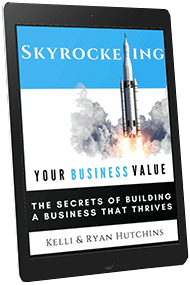
Value Drivers for a Financial Advisory Firm
Do you own a financial advisory firm or are looking to buy or sell a book of business? There are several important aspects that impact the value of your financial advisory firm. These are called “Value Drivers” It is important to evaluate these value drivers for your financial advisory practice, or the practice you are looking to buy.
Peak Business Valuation, business appraiser Utah, has valued dozens of financial advisory firms. We love helping individuals buy or sell a book of business. Schedule a free consultation to get started. A valuation analyst considers each of these value drivers when determining the value of a financial advisory firm.
What are the company’s top 3 clients as a percentage of total revenue?
First, a valuation expert looks at customer concentration. If 50% of the firm’s total revenue comes from the top 3 customers, then the book of business is considered to be highly concentrated. When a company has high customer concentration, there is an increased risk to the company. This is because if one, or more of those top clients decide to leave, then a large part of the company’s AUM and revenue leaves with them.
What are the total assets under management?
Total assets under management is important because the higher the AUM, the higher the commissions charged. Thus, the higher the revenue for the company.
What have historical growth rates in revenue and AUM been?
Has the company been growing? Has AUM been increasing? A good book of business will be increasing the total number of clients each year, the total AUM, and as a result, revenue.
How is the company growing? Organically, or inorganically?
Growth can happen in two fundamental ways: organic and inorganic. Organic growth comes as the company attracts new clients. Or the clients invest more money with the firm, etc. These are natural and organic ways of growth. This method of growth is generally more time-consuming but provides a longer-lasting client base and revenue stream.
Inorganic growth is growth via mergers or acquisitions. Is the company constantly purchasing other “books of business” to grow the company? This method of inorganic growth is fast, but generally more expensive upfront. In addition, client retention often drops because clients do not have the entire experience of being found, won over, and served well. Instead, these clients are suddenly subject to a new owner, a new advisor, and a new way of doing things. This often leads to client attrition.
What is the net new client rate?
Is the company finding new clients faster than it is losing clients? If this number is negative, it may be a sign that the company’s client base is unhappy with the current advisor, fees, or structure of the company. This means that the business is shrinking. As a result, AUM and revenue are also probably shrinking. A positive net new client rate means the firm is attracting clients faster than it loses them. This is a good sign of growth.
What is the average management percentage fee?
Management fees are important because they drive the revenue of financial advisor firms. Low management fees may make clients happier, but the revenue stream will suffer as a result. High management fees can increase revenue, but it can also drive clients away in search of an advisor with lower fees. So, generally, there is a “goldilocks zone” where the management fee is not too high or too low. The goal is to be low enough to be competitive in the market and attract new clients, but at the same time high enough to generate healthy revenue.
What percent of revenue is considered recurring versus fixed?
One of the key drivers to a successful financial advisory firm is the importance of recurring revenue. Recurring revenue is valuable because it is revenue earned each year without incurring any more work or expenses. In this business structure, each client pays an annual fee of AUM. As such, the only additional cost to the firm is to keep a happy client.
This contrasts with fee-based financial advisors. Fee-based financial advisors receive a fee for the work they perform. For this business structure to continue earning revenue, it must find new clients that are willing to pay the fees for the advisor’s advice and/or financial plans.
How many years of investment advice/experience does the advisor have?
This is especially important when it comes to a financial advisory firm. Individuals are very protective of their savings, and rightfully so. They work hard for their money. They want a trustworthy and experienced advisory to manage their retirement savings. Many individuals use experience as a key factor when deciding which financial advisor to use.
Is the client or referral base highly concentrated?
Are all the clients in one area? Are there other advisors that clients can turn to if they are not satisfied with your service? The concentration of your current clients and potential clients (referral base) might affect the value of your financial advisory practice.
What is the client demographic for your book of business?
How old is your client base? What is each client’s net worth? A client base consisting mainly of older, more mature clients will generally mean higher AUM and higher revenue. This is because these clients generally have a higher net worth. However, the future revenue potential for these clients is lower. This is because as age increases, they have a statistically higher risk of passing away.
On the contrary, the current revenue for younger and lower net worth individuals is less. But, there is the prospect of them staying with you for many years as they increase their net worth. A good book of business will have a diversified client base. This includes some mature clients, some younger clients, and some clients in between.
How easy is it for customers to switch advisors?
If the switching process is easy for your clients to move to a different advisor, there is additional risk associated with your practice. A company with high switching costs can encourage customers to stay with you. This also helps increase the value of your book of business.
How sophisticated are the software, internal processes, and policies/procedures?
Generally, software expense is the largest expense for financial advisors. Clients expect high-quality software everywhere they go. This expectation is no different when it comes to managing their money.
Investment software and market tracking systems are costly to put in place. However, a good system will help keep clients with your firm and will help increase the firm’s overall value.
Additionally, a company with clear policies and procedures can provide consistency and clarity for clients. A consistent approach will help a client feel more comfortable with the advisor and forge a strong relationship.
Summary
These are the most common value drivers Peak Business Valuation, business appraiser Utah, addresses when working with financial advisory firms. The above value drivers can help give you a rough idea of where you are succeeding, and where you can improve.
Peak Business Valuation, business appraiser Utah, is here to help you better understand the value of your financial advisory firm. We value several financial advisory firms each month that are looking to buy, sell or grow a book of business. We are happy to walk you through your business. Please reach out by scheduling your free consultation below.
For more information see Valuing a Financial Advisory Firm, Valuation Multiples for a Financial Advisory, and How to Value a Financial Advisory.
Schedule Your Free Consultation Today!
